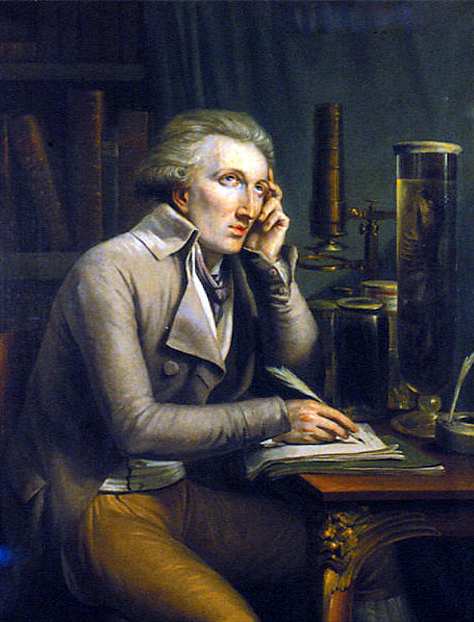“Cuvier” is one of those names often repeated without a given name, so great was his fame and influence in several fields of science. He almost single-handedly developed the modern study of comparative anatomy in biology, which he applied most masterfully in vertebrate paleontology, a field that he, again nearly single-handedly, crafted into a rigorous scientific discipline. But perhaps his greatest contribution was his demonstration of the extinction of species, which suggested the existence of numerous distinctly different biological epochs during the history of the Earth.
After a traditional, but privileged education in the Carolinian Academy in Stuttgart, Cuvier first worked as a private family tutor in Normandy and avoided the worst events of the French Revolution. He emerged thereafter in an appointment to the Muséum National d’Histoire Naturelle, newly formulated from earlier royalist collections, where he was first an assistant, and then professor of zoological anatomy. Although he always maintained important governmental appointments of one kind or another, under Napoleon and three Kings of France, he was foremost and ever-increasingly the world’s master naturalist by the sheer volume and energy of his work and its wide critical acclaim.
Thoughts on Extinction
In Cuvier’s time, the idea of extinction was entertained, but it was still in dispute. Evidence from the fossil record did exhibit some inexplicable variances between modern and ancient life forms. These differences, however, could be explained away as being the influence of different kinds of living environments on the organisms whose remains were observed. While it is true that some theological doctrines precluded the outright elimination of species by natural causes, as contrary to a Divine plan of perfect world creation, the enlightened world of scholars, who often themselves were pious men and less frequently theologians, at least entertained the idea that some life forms had been wholly extirpated—and so were extinguished at times even predating the presence of humans. What was most difficult to ascertain was what extinction meant in understanding the history of the earth.
Cuvier’s command of comparative anatomy allowed him to move away from the traditional view that the great variety of life forms (living and fossil) were the product of environmental influences. Cuvier argued that biological function within organisms dictated the morphology of organisms, and thus morphological similarities did not necessarily indicate common ancestry. Applying these principles—with which not all contemporary scholars agreed—to the fossil record, Cuvier discerned anatomical differences between animals that seemed to be similar, among living animals and those of the fossil record alike.
Probably his most eloquent studies were in elephant anatomy. Cuvier distinguished between the African and Indian living elephants of course, but he showed further that the fossil mammoths in turn differed from the elephants. And thus, mammoths must be extinct species, including those found in Italy that had been said to be the remains of Hannibal’s elephants used during the invasion of Rome in 211 B.C.E.! Cuvier made similar comparisons between elk and between sloths, the latter of which included Thomas Jefferson‘s American megalonyx, and eventually he separately classified the mammoths and their relations, mastodons.

